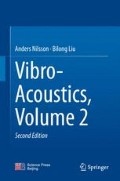Abstract
The excitation of some simple continuous systems like beams and plates was discussed in Chaps. 6 through 8. In the majority of those examples, the excitation of the structure was a point force or a pressure distribution across the surface of the structure. The response due to harmonic as well as white noise or random excitation was discussed. The response of a structure due to a random distribution of forces across a plate was discussed briefly in Sects. 7.4 and 8.2.
Access this chapter
Tax calculation will be finalised at checkout
Purchases are for personal use only
Author information
Authors and Affiliations
Corresponding author
Problems
Problems
15.1
A spatially stationary signal u(x) is defined as \(u(x) = A \cdot \cos (k_0 x)\). Determine the spatial autocorrelation function \(R_{uu} (\xi )\) defined in Eq. (15.4).
15.2
Determine the spatial spectral density \(\tilde{S}_{uu} (k)\) of the signal \(u(x) = A \cdot \cos (k_0 x)\).
15.3
A wave, displacement \(u(x,t) = A \cdot \sin [\omega _0 (t - x / c)]\), is propagating along the positive x-axis in a coordinate system. Determine the autocorrelation function \(R_{uu} (\xi ,\tau )\) and the corresponding spectral density \(\tilde{S}(k,\omega )\).
15.4
Use the expression \(\tilde{S}(k,\omega )\) derived in Problem 15.4 to calculate the time and space average of the displacement squared, \( \langle \bar{u}^2 \rangle \), for \(u(x,t) = A \cdot \sin [\omega _0 (t - x / c)]\).
15.5
Show that the time average of the input power to mode (m, n) to a plate is  where
where  is the total energy of that mode and \(\eta \) is the loss factor and \(\omega _{mn} \) the natural angular frequency for that mode. Assume rain on the roof excitation.
is the total energy of that mode and \(\eta \) is the loss factor and \(\omega _{mn} \) the natural angular frequency for that mode. Assume rain on the roof excitation.
15.6
A beam is simply supported at both ends. The beam is excited by a random force per unit length. The autocorrelation function of the force is \(R_{{F}'{F}'} (\xi ,\tau ) = S_0 \cdot \delta (\xi ) \cdot \delta (\tau )\) where \(\xi \) is the separation in space and \(\tau \) in time of the force function. The bending stiffness of the beam is \({D}'\), its mass per unit length \({m}'\) and its length L. Determine the space and time average of the kinetic energy of the beam.
15.7
Solve Eqs. (15.70) and (15.71).
15.8
Show that the autospectrum of the velocity of a flat plate excited by a TBL is proportional to \(1/h^3\) where h is the thickness of the plate.
15.9
Show that the velocity squared of a water loaded plate excited by a water flow is proportional to \(h^{ - 9 / 4}\).
Rights and permissions
Copyright information
© 2016 Science Press, Beijing and Springer-Verlag Berlin Heidelberg
About this chapter
Cite this chapter
Nilsson, A., Liu, B. (2016). Random Excitation of Structures. In: Vibro-Acoustics, Volume 2. Springer, Berlin, Heidelberg. https://doi.org/10.1007/978-3-662-47934-6_15
Download citation
DOI: https://doi.org/10.1007/978-3-662-47934-6_15
Published:
Publisher Name: Springer, Berlin, Heidelberg
Print ISBN: 978-3-662-47933-9
Online ISBN: 978-3-662-47934-6
eBook Packages: Physics and AstronomyPhysics and Astronomy (R0)

